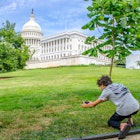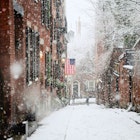
Oct 17, 2025 • 6 min read
For those seeking a tropical island paradise and the warm vibes that comes with it, there isn’t a bad time to visit Key West.

Oct 17, 2025 • 6 min read
For those seeking a tropical island paradise and the warm vibes that comes with it, there isn’t a bad time to visit Key West.

Oct 17, 2025 • 10 min read
All the insider tips on how to make the most of a family trip to Washington, DC, whether you're traveling with toddlers or teens.

Oct 17, 2025 • 8 min read
The Mexican state of Oaxaca promises rich historic, cultural and natural treasures. Here’s a full guide for visitors.

Oct 17, 2025 • 8 min read
From sheep-shearing to wife-carrying, there’s much more to sports than what’s on TV. These are 10 of the weirdest ones from around the world.

Oct 17, 2025 • 10 min read
Don’t miss these top experiences in Brazil’s coolest city, from spectacular green space to top-notch museums and best-in-class cuisine.

Oct 17, 2025 • 6 min read
Everything you need to know about visiting Central America's largest country.

Oct 17, 2025 • 9 min read
In three hours or less, you can visit buzzing university towns, vineyards, lakes and even dinosaur footprints. Here are the top day trips from Dallas.

Oct 17, 2025 • 14 min read
Northern Greece is the mythical home of the ancient Greek gods where you can go swimming in waterfalls and hike through the world's deepest gorge.

Oct 17, 2025 • 12 min read
With natural riches and extraordinary culture, Oaxaca epitomizes Mexico’s most special qualities. Here are some of the state's top experiences.

Oct 16, 2025 • 10 min read
The Da Vinci Code author's latest novel takes place in the Czech capital and could be read as a guide to city, as it mentions many sites worth visiting.

Oct 16, 2025 • 7 min read
These cultural gems take even the most severe Boston winter from cold to cozy.

Oct 16, 2025 • 8 min read
Some of England’s train stations are not just gateways to travel but destinations in themselves. Here's our pick of the best.

Oct 16, 2025 • 6 min read
Make any voyage a breeze with our top packing tips.

Oct 16, 2025 • 6 min read
Lisbon is one of Europe's top city breaks. Here are the best things to do when you visit.

Oct 16, 2025 • 5 min read
Get the ins and outs of entering and exiting Cambodia, with the lowdown on fees, getting a visa on arrival, e-visas and land borders.

Oct 16, 2025 • 7 min read
Affordable travel in New Zealand is possible – if you plan carefully.

Oct 16, 2025 • 6 min read
You'll find everything from white water kayaking, to the NASCAR museum, to some serious BBQ. Here are the top ways to live it up during your trip.

Oct 16, 2025 • 7 min read
From dining in top restaurants to wandering through Old Sacramento, here's how to experience the best of California's capital.

Oct 15, 2025 • 7 min read
Mobile, Alabama, is an unsung hero in the southern US, offering visitors an incredible music scene, great food, history and tons of cultural clout.

Oct 15, 2025 • 14 min read
With the sparkliest lights and in the most idyllic winter settings, these European Christmas markets will shine bright in 2025.

Oct 15, 2025 • 4 min read
From wildlife spotting to blokarting to kicking back with sunset beers, Auckland has the right beach for you.

Oct 15, 2025 • 5 min read
Amazing day trips from Auckland delve into gold-mining history, Māori culture, outdoor adventures, quality food and drink, and unforgettable scenery.